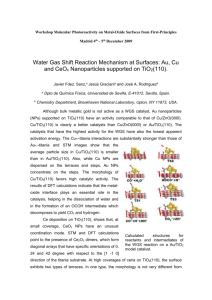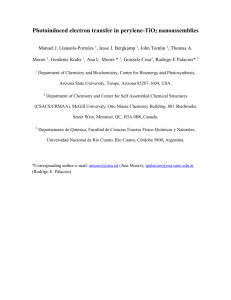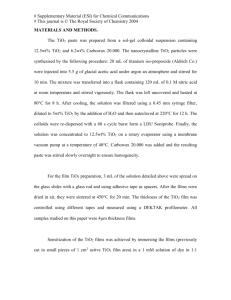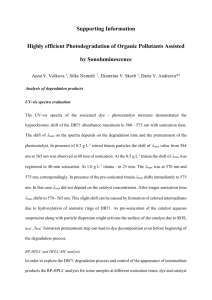Supplementary Data - Springer Static Content Server
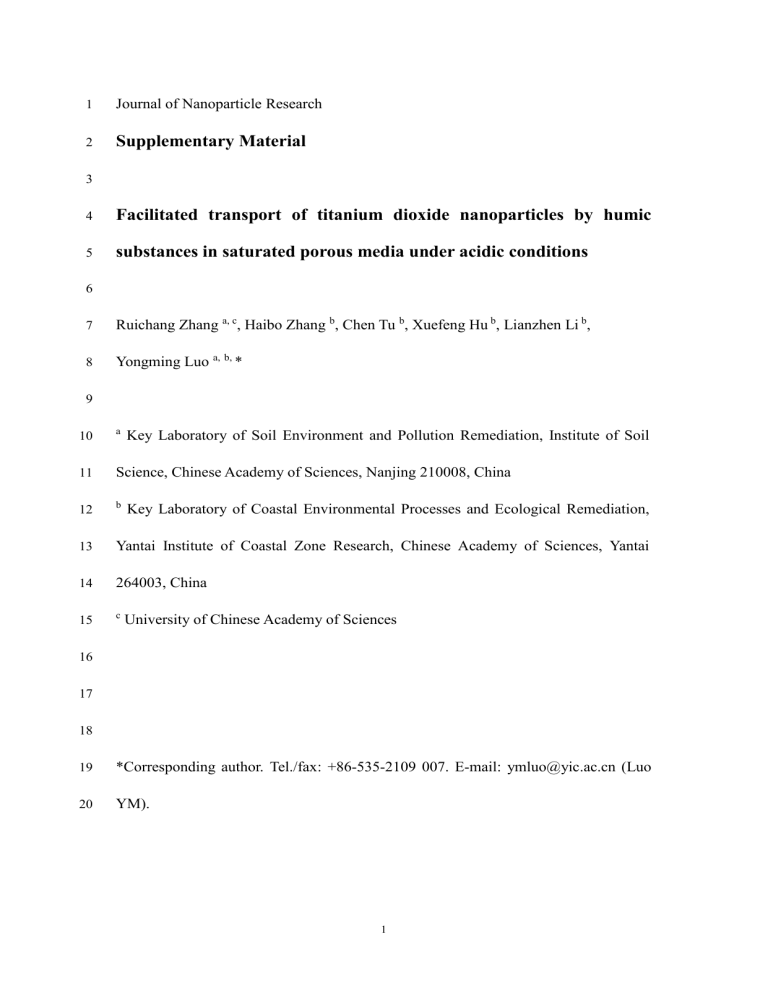
1 Journal of Nanoparticle Research
2
Supplementary Material
3
4
Facilitated transport of titanium dioxide nanoparticles by humic
5
substances in saturated porous media under acidic conditions
6
7 Ruichang Zhang a, c
, Haibo Zhang b
, Chen Tu b
, Xuefeng Hu
b
, Lianzhen Li
b
,
8 Yongming Luo a, b,
*
9
10 a
Key Laboratory of Soil Environment and Pollution Remediation, Institute of Soil
11 Science, Chinese Academy of Sciences, Nanjing 210008, China
12 b
Key Laboratory of Coastal Environmental Processes and Ecological Remediation,
13 Yantai Institute of Coastal Zone Research, Chinese Academy of Sciences, Yantai
14 264003, China
15 c
University of Chinese Academy of Sciences
16
17
18
19 *Corresponding author. Tel./fax: +86-535-2109 007. E-mail: ymluo@yic.ac.cn (Luo
20 YM).
1
21
22
23
1500
1000
500
Anatase
0
10 20 30 40
2
50 60 70 80
Fig. S1 XRD pattern of TiO
2
NPS in the present study
2
24
25
60
40
20
0
-20
-40
TiO
2
NPs
HS
Quartz
-60
2 3 4 5 pH
6 7 8
Fig. S2 Zeta potentials of bare TiO
2
NPs, HS and quartz in deionized water
3
26
27
3455
2937
2874
937
1106
1036
1387
1631
4000 3500 3000 2500 2000 1500 1000 500
Wave number (cm
-1
)
Fig. S3 FTIR spectrum of HS in this study
4
28
29
Table S1 The assignmen of absorption bands in FTIR spectrum of HS
Wavenumber (cm -1 )
3455
2937
2874
1631
1387
1106
1036
937
Assignment
OH stretching vibration
Aliphatic CH
2
stretching vibration
CH
2
symmetric stretching vibration
Aromatic C=C stretching vibration
COO symmetric stretching vibration
Aliphatic C-OH stretching vibration
C-O-C stretching
Aliphatic C-C vibration
5
30
31
1.0
y=0.039x+0.006
R
2
=0.999
0.8
0.6
y=0.011x+0.003
R
2
=0.999
0.4
0.2
TiO
2
NPs at 343 nm
HS at 228 nm
0.0
0 20 40
Concentration (mg L
-1
)
60 80
Fig. S4 Calibration curves for UV light absorbance of TiO
2
NPs and HS
6
32 Table S2 Physiochemical parameters of transport experiments of TiO
2
NPs.
Background condition pH Na +
(mmol L -1 )
Ca 2+
(mmol L -1 )
HS
(mg L -1 )
Porosity Flow velocity
(cm min -1 )
0 mg L -1 HS
0.5 mg L -1 HS
1 mg L -1 HS
5 mg L -1 HS
10 mg L -1 HS pH 4.0
4.0
4.0
4.0
4.0
4.0
4.0
0.1
0.1
0.1
0.1
0.1
0.1
0
0.5
1
5
10
0.5
0.45
0.42
0.47
0.46
0.45
0.42
0.36
0.36
0.36
0.38
0.37
0.36 pH 5.0 5.0 pH 6.0
1 mmol L -1 NaCl
6.0
5.0
10 mmol L -1 NaCl
100 mmol L -1 NaCl
5.0
5.0
250 mmol L -1 NaCl 5.0
0.5 mmol L -1 CaCl
2
5.0
1 mmol L -1 CaCl
2
2 mmol L -1 CaCl
2
5 mmol L -1 CaCl
2
5.0
5.0
5.0
250
0.1
0.1
1
10
100
0.5
1
2
5
5
5
5
5
5
0.5
0.5
5
5
5
0.42
0.44
0.42
0.42
0.46
0.45
0.43
0.43
0.45
0.43
0.37
0.37
0.37
0.36
0.36
0.36
0.36
0.36
0.37
0.35
7
33
Adsorption of HS onto TiO
2
NPs
34 To quantitatively evaluate the effects of HS on the stability and transport behavior of
35 TiO
2
NPs observed in column experiments, adsorption studies were conducted to
36 determine the amount of HS adsorbed onto TiO
2
NPs in conditions identical to those
37 used in transport experiments. The suspended particles in TiO
2
NPs suspension
38 prepared above were pelleted by sequential centrifugation (Chen et al. 2012). Briefly,
39 10 mL suspensions were added to Teflon centrifuge tubes and centrifuged for 20
40 minutes at 9,400
g (3K 15, Sigma Laborzentrifugen). Then 8 mL of supernatant
41 were carefully withdrawn from each tube and transferred into another clean centrifuge
42 tube for centrifugation. This procedure was repeated until the TiO
2
NPs was
43 completely removed from the solution. The HS concentration in the supernatant was
44 determined using a spectrophotometer (GENESYS 10S UV-Vis, Thermo Scientific)
45 at 228 nm. The adsorbed HS were then determined by the difference between the
46 initial and final HS concentrations in the aqueous phase. Control experiments with
47 TiO
2
NPs-free solutions showed no variations in HS concentrations before and after
48 the centrifugation processes in the range of HS concentrations tested.
8
0.8
a
0.6
0.4
pH 4.0
pH 5.0
pH 6.0
0.2
0.0
1 10
HS (mg L
-1
)
0.35
b
0.30
0.25
0.20
0.15
49
50
0.10
1 10
NaCl (mmol L
-1
)
100
Fig. S5 Amounts of HS a dsorbedonto the TiO
2
NPs surface as a function of pH and
51 HS concentration (0.1 mmol L
-1
NaCl) (a), and NaCl concentration (5 mg L
-1
HS and
52 pH 5.0) (b) in the TiO
2
suspension
9
3413 2928
HS coated TiO
2
NPs
1625
1389
1042
1118
514
TiO
2
NPs
53
54
55
56
57
4000 3500 3000 2500 2000 1500 1000 500
Wave number (cm
-1
)
Fig. S6 FTIR spectra of TiO
2
NPs and HS coated TiO
2
NPs. Peaks at 2928 cm
-1
for aliphatic CH
2
, 1118 cm
-1 for aliphatic C-OH, and 1042 cm
-1
for C-O-C in FTIR spectra of HS coated TiO
2
NPs could reasonably inferred the adsorption of HS onto the surface of TiO
2
NPs.
10
58
Particles attachment efficiency
59 Using the single collector efficiency model, a dimensionless contact efficiency
η
0
60
61 could be calculated as follows (Tufenkji and Elimelech 2004),
0
D I G
(S1)
62 Where
η
D
,
η
I
, and
η
G
are collector efficiency components for particles transported to
63 the collector due to diffusion, interception, and gravity, respectively. Diffusion is
64 associated with smaller particles when they undergo Brownian motion due to random
65 bombardment by molecules of the suspending medium and as a result come in contact
66 with the collector surface. Interception occurs when the moving particles contact with
67 the collector grain while traveling along a streamline. Gravitational sedimentation is
68 related to the settling of particles on collector grains by the combined effects of the
69 buoyant weight of the particle and the fluid drag on the particles (Rahman et al. 2013;
70 Yao et al. 1971).
71 Single collector contact efficiency can also be calculated using the following equation
72
73 in detail (Tufenkji and Elimelech 2004):
0
2.4
1/3 A N s R
0.081
N
Pe
0.715
N vdW
0.052
0.55
1.675
N N
R A
0.125
0.22
0.24
1.11
N N N
R G vdW
0.053
(S2)
74 Where A s
is the porosity-dependent parameter of Happel’s model:
75
76
A s
p 5 2(1 )
2 3 p
3 p 5
2 p 6
(S3)
Here p is determined according to p
) 1/3 , where ε is the porosity of a porous
77 medium.
78 N
R
is the aspect radio, which is defined as:
11
79 N
R
d p d c
(S4)
80 Where d p
and d c
are the diameter of TiO
2
NPs aggregate and quartz packed in column
81 respectively.
82 N
Pe
is Peclet number, which is described as:
83 N
Pe
Ud c
D
(S5)
84 Where U is the approach (superficial) velocity of the TiO
2
NPs suspension, and D
∞
is
85 the diffusion coefficient in an infinite medium, which is calculated using:
86 D
kT
6
a p
(S6)
87 Here, k is the Boltzmann constant, 1.3805×10
-23
, T is the temperature in degree of
88 Kelvin, 293 K,
μ is the absolute viscosity of fluid, and a p
is the radius of TiO
2
NPs.
89
90
91
N vdW
is the van der Waals number, which is defined as:
N vdW
A kT
(S7)
Where A is the Hamaker constant for the interacting system of TiO
2
NPs -water-quartz,
92 and was assumed to be 1.0×10 -20
.
93
94
N
G
is the gravity number obtained by the following equation:
N
G
a p
2 2 (
p
9
U f
) g
(S8)
95 Where
ρ p
and
ρ f
is the density of TiO
2
NPs and fluid respectively, and g is the
96 gravitational acceleration, 9.81 m s
-2
.
97 N
A
is the attraction number, which is calculated using:
98 N
A
12
A
2 a U p
(S9)
12
99 Essentially, η
0
is the probability that a particle will collide with the collector grain
100 through one of the three modes of transport (diffusion, interception, and transport),
101 depending on system hydrodynamics, particle size, density, and van der Waal’s forces
102 (Saleh et al. 2008).
103 Under conditions relevant to most aquatic systems, the single collector removal
104 efficiency η is lower than the single collector contact efficiency η
0
due to repulsive
105 colloidal interactions between particles and collector grains (Tufenkji and Elimelech
106 2004). The actual single collector removal efficiency is often expressed using eq. S10,
107
2 d
c
3(1
) L ln( C C i
/
0
) (S10)
108 Here, d c is the average diameter of the collector particles,
ε is packed bed porosity, L
109 is the length of the column, and C
0 and C i are influent and effluent particle
110 concentration, respectively.
111
The attachment efficiency or “sticking coefficient” α
in eq. S11 represents the fraction
112 of collisions between particles and collectors that result in attachment, i.e., describes
113 the ratio between the experimental single collector removal efficiency
η
and the
114
115 predicted single collector contact efficiency
η
0
.
0
(S11)
116
13
117
Derjaguin–Landau–Verwey–Overbeek (DLVO) theory
118 DLVO theory was applied to evaluate the role of electrostatic and van der Waals
119 interactions on the interaction between the nanoparticles and the nanoparticle-quartz
120 surfaces.
121
Total
vdW
dl
(S12)
122 DLVO interaction energies between TiO
2
NPs were calculated assuming
123 sphere-sphere geometry by utilizing the following equations (Gregory 1981):
124
125
vdW
dl
( )
2
a r p p
2
A a
101 p
(S13)
h )
(S14)
126 Interaction profiles for nanoparticles and quartz sand particles were developed
127 assuming sphere-plate geometry and the following equations were used for
128 calculation (Gregory 1981):
129
130
dl
vdW
A a
102 p
(S15)
0 a r p
2
p c ln
h
h )
)
2
p
c
2
h )
(S16)
131 In DLVO interaction energy profiles, positive interaction energy values represent
132 repulsive condition whereas negative interaction energy values correspond to
133 attraction.
134 When DLVO interaction energy between TiO
2
NPs is calculated, a p
is the radius of
135 the initial TiO
2
NPs, 30 nm, and in the case of the energy between TiO
2
NPs and
136 quartz surface, the radius of an equivalent sphere for the nanoparticle aggregates
137 which were measured by DLS has been used as the nanoparticle radius ( a p
). h denotes
14
138 the (minimum) surface-to-surface separation distance between the spheres (for
139 sphere–sphere geometry) or between a sphere and a plate (for sphere–plate geometry).
140 A characteristic wavelength (
λ
) of 100 nm was assumed in the calculations.
141 Permittivity of free space (
ε
0
) and dielectric constant (
ε r
) of water are 8.854×10
-12
C
142 V
-1
m
-1
and 81.5 respectively,
κ is the inverse Debye length (m
-1
) which was estimated
143 for each electrolyte solution using eq. S17, and ψ p
and ψ c
are the surface potentials of
144 TiO
2
NPs and quartz collector (V), respectively. For the calculation of interaction
145 profiles, zeta potentials of TiO
2
NPs and quartz were measured under different
146 chemical conditions and these values were used instead of surface potentials. The
147 Hamaker constant for TiO
2
NPs–water–TiO
2
NPs interaction system ( A
101
) used was
148 3.7×10 -20 J (Shih et al. 2012) and for TiO
2
NPs–water–quartz system ( A
102
) 1.0×10 -20 J
149 was used (Chowdhury et al. 2011).
150
10 3 2 e N (2 )
A
0 r kT
1/ 2
151 (S17)
?
152 Where e is the electron charge, 1.60×10
-19
C, N
A
is Avogadro’s constant, 6.02×10
23
153 mol
-1
, and I is the ionic strength of the solution.
15
0
-5
-5
-10
5
0
20
15
10 a
0
10
5 b
0 mg L
-1
0.5 mg L
-1
1 mg L
-1
5 mg L
-1
10 mg L
-1
10 20 30
Separation Distance (nm)
pH 4.0
pH 5.0
pH 6.0
40
154
155
-10
0 10 20 30
Separation Distance (nm)
40
Fig. S7 Calculated DLVO interaction energy between TiO
2
NPs (based on primary
156 size) under varying HS concentrations (pH 4.0 and 0.1 mmol L
-1
NaCl) (a), and under
157 varying pH (5 mg L -1 HS and 0.1 mmol L -1 NaCl) (b)
16
158
159
160
0.6
0.4
0.2
1.0
0.8
0.0
0 1 2 3 4 5
PV
Fig. S8 Breakthrough curve of conservative Br-tracer (0.1 mmol L
-1
, pH 4.0 and 0.1 mmol L
-1
NaCl) in quartz sands.
17
1.0
a
0.8
0.6
0.4
0.2
0.6
0.4
0.2
0.0
0
1.0
b
0.8
1 2
PV
3
0 mg L
-1
1 mg L
-1
5 mg L
-1
10 mg L
-1
4
0 mg L
-1
1 mg L
-1
5 mg L
-1
10 mg L
-1
5
161
162
163
0.0
0 1 2 3 4 5
PV
Fig. S9 Breakthrough curves for TiO
2
NPs under different HS concentrations at pH
5.0 (a) and pH 6.0(b)
18
600
400
200
0
-200
-400 a
0 10 20 30
Separation Distance (nm)
0 mg L
-1
0.5 mg L
-1
1 mg L
-1
5 mg L
-1
10 mg L
-1
40
400 b
pH 4.0
pH 5.0
pH 6.0
200
0
-200
164
165
166
167
0 10 20 30 40
Separation Distance (nm)
Fig. S10 Calculated DLVO interaction energy between TiO
2
NPs (based on aggregated size) and quartz under varying HS concentrations (pH 4.0 and 0.1 mmol
L -1 NaCl) (a), and under varying pH (0.5 mg L -1 HS and 0.1 mmol L -1 NaCl) (b)
19
30
25
20
15
10
pH 5.0
1 mg L
-1
HS
2 mmol L
-1
CaCl
2
168
169
170
171
5
0
100 1000 10000
Hydrodynamic Diameter (nm)
Fig. S11 Representative number-weighted hydrodynamic diameter distribution of the
TiO
2
NPs in the influent samples at 0.5 mg L
-1
HS, 1 mg L
-1
HS and 2 mmol L
-1
CaCl
2
. The solid lines are drawn to provide visual guides
20
172
References
173 Chen GX, Liu XY, Su CM (2012) Distinct effects of humic acid on transport and
174
175 retention of TiO
2
rutile nanoparticles in saturated sand columns. Environ Sci
Technol 46:7142-7150 doi:Doi 10.1021/Es204010g
176 Chowdhury I, Hong Y, Honda RJ, Walker SL (2011) Mechanisms of TiO
2
nanoparticle
177 transport in porous media: Role of solution chemistry, nanoparticle
178 concentration, and flowrate. J Colloid Interf Sci 360:548-555 doi:DOI
10.1016/j.jcis.2011.04.111 179
180 Gregory J (1981) Approximate expressions for retarded Vanderwaals interaction. J
181 Colloid Interf Sci 83:138-145 doi:Doi 10.1016/0021-9797(81)90018-7
182 Rahman T, George J, Shipley HJ (2013) Transport of aluminum oxide nanoparticles in
183
184 saturated sand: Effects of ionic strength, flow rate, and nanoparticle concentration. Sci Total Environ 463:565-571 doi:DOI
185 10.1016/j.scitotenv.2013.06.049
186 Saleh N, Kim HJ, Phenrat T, Matyjaszewski K, Tilton RD, Lowry GV (2008) Ionic
187
188 strength and composition affect the mobility of surface-modified Fe-0 nanoparticles in water-saturated sand columns. Environ Sci Technol
189
191
42:3349-3355 doi:Doi 10.1021/Es071936b
190 Shih YH, Liu WS, Su YF (2012) Aggregation of stabilized TiO
2
nanoparticle suspensions in the presence of inorganic ions. Environ Toxicol Chem
192 31:1693-1698 doi:Doi 10.1002/Etc.1898
193 Tufenkji N, Elimelech M (2004) Correlation equation for predicting single-collector
21
194 efficiency in physicochemical filtration in saturated porous media. Environ Sci
Technol 38:529-536 doi:Doi 10.1021/Es034049r 195
196 Yao KM, Habibian MM, Omelia CR (1971) Water and waste water filtration:
197 Concepts and applications. Environ Sci Technol 5:1105-1113 doi:Doi
10.1021/Es60058a005 198
199
22




